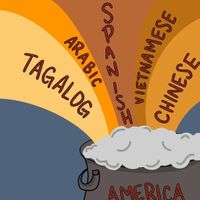The war in Ukraine is leading to a linguistic backlash in Russophone Central Asia as young people embrace their mother tongues. This shift is part of a broader trend seen since the Soviet era, where the imposition of the Russian language was a tool of cultural and linguistic erasure. The Soviet Union, particularly under Joseph Stalin, implemented a policy of Russification aimed at consolidating control over diverse ethnic groups. This policy gained traction in the 1920s, pushing a unified Soviet identity over individual ethnic identities and establishing Russian as the lingua franca across Soviet territories.
Since Russia’s full-scale invasion of Ukraine in February 2022, many Ukrainians have made a concerted effort to speak Ukrainian, even if their native language is Russian. This phenomenon is not unique to Ukraine; efforts to dismantle Russian linguistic influence have taken root in many former Soviet republics, particularly in the Baltics. In Central Asia, however, the shift in language policy is a relatively new development, with Uzbekistan’s decision to switch from the Cyrillic alphabet to the Latin one in 2021 marking an early sign of change.
After the invasion of Ukraine, Kyrgyzstan welcomed a significant influx of Russian migrants, many fleeing conscription or protesting the war. In 2022, 273,000 Russian citizens registered in Kyrgyzstan, a 30 percent increase from 2021. This sudden surge altered the demographic landscape, increasing the number of Russian speakers in the country. The Kyrgyz government even offered a digital nomad visa, attracting many Russian citizens seeking refuge.
In response to the growing Russian presence, a debate has emerged in Kyrgyzstan about the need to protect indigenous languages and traditions from what many perceive as a new wave of Russian imperialism. The influx of Russian speakers has intensified discussions about language policy, especially as Central Asian leaders seek to distance themselves from Russia while remaining officially neutral regarding the conflict in Ukraine.
Historically, Russian became the primary language of education, administration, and communication in Central Asia during the Soviet era. Russian-language schools were often viewed as more prestigious, leading to a societal perception that Russian was more useful and intellectual than local languages. Official processes, including registration, banking, and medical services, were typically conducted in Russian, further entrenching its dominance.
The relationship between Kyrgyzstan and Russia has been fraught since the Russian Empire occupied the region in 1876. Soviet policies sought to eradicate Kyrgyzstan's nomadic heritage, promoting communist ideals and standardizing language while settling ethnic Russians in urban areas. As Russia's influence wanes, language policy is becoming a critical tool for bolstering nationalism and dismantling an imperial past.
While Russian retains official status in Kyrgyzstan, recent legislative changes reflect a shift towards promoting the Kyrgyz language. In 2023, Kyrgyz President Sadyr Japarov signed legislation requiring all Kyrgyz officials to use Kyrgyz in official settings, including parliament. This move has been met with criticism from Russian officials, signaling a diplomatic shift away from Moscow.
The divide between Russian-speaking and Kyrgyz-speaking populations has long been a point of political contention. Russian speakers, primarily residing in urban areas like Bishkek, often align with the metropolitan elite, while Kyrgyz speakers tend to live in rural areas. This urban-rural divide played a significant role in Kyrgyzstan’s 2020 election, where Japarov garnered support from rural voters disillusioned with the political elite.
Young Kyrgyz people in Bishkek are increasingly prioritizing the Kyrgyz language, viewing it as essential for employment and cultural connection. Meerim Abdiraimova, an ethnic Kyrgyz woman working at an international organization, learned Kyrgyz as an adult to connect with her heritage and enhance her job prospects. She noted that resources for learning Kyrgyz were scarce, especially as many young people sought opportunities abroad.
Instagram pages like Tilimpoz now offer written resources for learning Kyrgyz, framing language acquisition as a form of resistance to Russian imperialism. The growing demand for Kyrgyz language classes reflects a shift in priorities, with more foreigners also beginning to learn the language. Cholpon Beshkempirova, head of Lingua Yurt language school in Bishkek, reported increased interest in Kyrgyz classes, indicating a broader recognition of the importance of local languages for international work.
Despite the push for Kyrgyz language education, challenges remain. In 2024, the Kyrgyz and Russian governments ratified an agreement to establish nine Russian-language schools in Kyrgyzstan, which could undermine efforts to promote Kyrgyz. Furthermore, Kyrgyzstan’s economic reliance on Russia complicates the situation. In 2021, Kyrgyzstan’s exports to Russia were valued at $393 million, but by 2022, this figure had surged to over $1 billion, partly due to Kyrgyzstan's role in helping Russia circumvent Western sanctions.
As Kyrgyzstan navigates its relationship with Russia, the focus on language policy signals a desire to assert national identity and cultural independence. While Russian remains a significant presence, the growing emphasis on Kyrgyz reflects a broader movement towards de-Russification and the reclamation of cultural heritage.
In conclusion, the war in Ukraine has catalyzed a linguistic and cultural awakening in Kyrgyzstan and beyond, as young people increasingly embrace their native languages. The ongoing debate over language policy underscores the complexities of national identity in a region still grappling with the legacy of imperialism.

